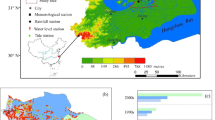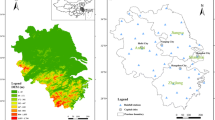Abstract
Regional climate change as well as urbanization are likely to introduce characteristics of non-stationarity in the extreme water levels (EWL), which in turn will affect the possibility of flooding in the plain river network region. For this study, China’s Taihu Basin as a typical case for analyzing the impacts that climate change and urbanization will have on changes in the EWL. Additionally, changes in the response that EWL will have toward future climate change and urbanization are also studied. A generalized additive model for location, scale and shape (GAMLSS) model with time (t), precipitation (pre) and population (pop) as major predictors was constructed to empirically investigate. Results indicate that the time dependent variables of the GAMLSS clearly describe the temporal variation of the EWL. The GAMLSS with physically-based covariates can capture additional details regarding the changing properties of EWL. According to changes exhibited in the EWL Akaike information criterion values, it is found that the impacts of climate change covariates are larger than that of the urbanization covariates. Additionally, for the study’s sample period of 2015–2099, an increasing trend is found for EWL under the RCP2.6 and RCP4.5 scenarios. It is concluded that flooding risk is likely to increase in China’s Taihu Basin with changing environment conditions, and that some necessary measures should be taken by local water resource management authorities to address the potential risks posed to the region.








Similar content being viewed by others
References
Akaike H (1974) A new look at the statistical model identification. IEEE Trans Autom Control 19(6):716–723
Angeles ME, González JE, Ramírez N (2018) Impacts of climate change on building energy demands in the intra-Americas region. Theor Appl Climatol 133(1–2):59–72
Chen P, Wang Y, You G, Wei C (2017) Comparison of methods for non-stationary hydrologic frequency analysis: case study using annual maximum daily precipitation in Taiwan. J Hydrol 545:197–211
Debele SE, Strupczewski WG, Bogdanowicz E (2017) A comparison of three approaches to non-stationary flood frequency analysis. Acta Geophys 65(4):863–883
Dey P, Mishra A (2017) Separating the impacts of climate change and human activities on streamflow: a review of methodologies and critical assumptions. J Hydrol 548:278–290
Douglas EM, Vogel RM, Kroll CN (2000) Trends in floods and low flows in the United States: impact of spatial correlation. J Hydrol 240(1):90–105
Galloway GE (2011) If stationarity is dead, what do we do now? J Am Water Resour Assoc 47(3):8
Gao Y, Mao X, Xu W (2006) Analysis of the influence on the Taihu Lake and the area around diversion from the Yangtze river to the Taihu lake. J China Hydrol 26(1):92–94 (in Chinese)
Gao M, Mo D, Wu X (2016) Non-stationarity modeling of extreme precipitation in China. Atmos Res 182:1–9
Gilroy KL, Mccuen RH (2012) A non-stationarity flood frequency analysis method to adjust for future climate change and urbanization. J Hydrol 414(2):40–48
Giraldo Osorio JD, García Galiano SG (2012) Non-stationary analysis of dry spells in monsoon season of Senegal River Basin using data from Regional Climate Models (RCMs). J Hydrol 450–451:82–92
Gu H, Ma Z, Li M (2016a) Effect of a large and very shallow lake on local summer precipitation over the Lake Taihu basin in China. J Geophys Res Atmos 121(15):8832–8848
Gu X, Zhang Q, Singh VP, Chen X, Liu L (2016b) Nonstationarity in the occurrence rate of floods in the Tarim River basin, China, and related impacts of climate indices. Glob Planet Change 142:1–13
Gulacha MM, Mulungu DMM (2016) Generation of climate change scenarios for precipitation and temperature at local scales using SDSM in Wami-Ruvu River Basin Tanzania. Phys Chem Earth 100:62–72
IPCC (2014) Climate Change 2014: Synthesis Report. Contribution of Working Groups I, II and III to the Fifth Assessment Report of the Intergovernmental Panel on Climate
Katz RW (2013) Statistical methods for non-stationarity extremes. Extremes in a changing climate. Springer Netherlands, Amsterdam, pp 15–38
Khaliq MN, Ouarda TBMJ, Ondo JC, Gachon P, Bobee B (2006) Frequency analysis of a sequence of dependent and/or non-stationary hydro-meteorological observations: a review. J Hydrol 329:534–552
Kucharavy D, De Guio R (2015) Application of logistic growth curve. Procedia Eng 131:280–290
Li H, Zhang Q, Singh VP, Shi P, Sun P (2017) Hydrological effects of cropland and climatic changes in arid and semi-arid river basins: a case study from the Yellow River basin, China. J Hydrol 549:547–557
Liang Z, Yang J, Hu Y, Wang J, Li B, Zhao J (2018) A sample reconstruction method based on a modified reservoir index for flood frequency analysis of non-stationary hydrological series. Stoch Environ Res Risk Assess 32:1561–1571
Liu L, Xu Z, Reynard NS, Hu C, Jones RG (2013) Hydrological analysis for water level projections in Taihu Lake, China. J Flood Risk Manag 6(1):14–22
Liu D, Guo S, Shao Q, Liu P, Xiong L, Wang L, Hong X, Xu Y, Wang Z (2018) Assessing the effects of adaptation measures on optimal water resources allocation under varied water availability conditions. J Hydrol 556:759–774
López J, Francés F (2013) Non-stationary flood frequency analysis in continental Spanish rivers, using climate and reservoir indices as external covariates. Hydrol Earth Syst Sci 17(8):3189–3203
Lu S, Yuan Y, Jin X, Jiao W, Wu Y, Ren D, Zhou Y, Chen L (2012) Speciation distribution of nitrogen in sediments of 7 rivers around Taihu Lake. Chin J Environ Sci 33:1497–1502
Milly PCD, Betancourt J, Falkenmark M, Hirsch RM, Kundzewicz ZW, Lettenmaier DP, Stouffer RJ (2008) Stationarity is dead: whither water management? Science 319(5863):573–574
Milly PCD, Betancourt J, Falkenmark M, Hirsch RM, Kundzewicz ZW, Lettenmaier DP, Stouffer RJ, Dettinger MD, Krysanova V (2015) On critiques of “stationarity is dead: whither water management?”. Water Resour Res 51(9):7785–7789
Mullan D, Chen J, Zhang XJ (2016) Validation of non-stationary precipitation series for site-specific impact assessment: comparison of two statistical downscaling techniques. Clim Dyn 46(3–4):967–986
Pei F, Wu C, Liu X, Hu Z, Xia Y, Liu L, Wang K, Zhou Y, Xu L (2018) Detection and attribution of extreme precipitation changes from 1961 to 2012 in the Yangtze River Delta in China. CATENA 169:183–194
Pendergrass AG (2018) What precipitation is extreme? Science 360:1072–1073
Penning-Rowsell EC, Yanyan W, Watkinson AR, Jiang J, Thorne C (2013) Socioeconomic scenarios and flood damage assessment methodologies for the Taihu Basin, China. J Flood Risk Manag 6(1):23–32
Pervez MS, Henebry GM (2014) Projections of the Ganges–Brahmaputra precipitation—downscaled from GCM predictors. J Hydrol 517:120–134
Qi W, Liu J (2018) A non-stationary cost-benefit based bivariate extreme flood estimation approach. J Hydrol 557:589–599
Razmi A, Golian S, Zahmatkesh Z (2017) Non-stationary frequency analysis of extreme water level: application of annual maximum series and peak-over threshold approaches. Water Resour Manag 31(7):2065–2083
Rigby RA, Stasinopoulos DM (2005) Generalized additive models for location, scale and shape. Appl Stat 54(3):507–554
Serinaldi F, Kilsby CG (2012) A modular class of multisite monthly rainfall generators for water resource management and impact studies. J Hydrol 464–465:528–540
Shan Y, Cai W, Xue X, Wang D (2018) The impacts and countermeasures of developing urban flood control systems around Taihu Lake. China Flood Drought Manag 2(28):56–65 (in Chinese)
Song S, Xu Y, Zhang J, Li G, Wang Y (2018) The long-term water level dynamics during urbanization in plain catchment in Yangtze River Delta. Agric Water Manag 174:93–102
Tsoularis A, Wallace J (2002) Analysis of logistic growth models. Math Biosci 179(1):21–55
Verhulst PF (1838) Notice sur la loi que la population suit dans son accroissement. Correspondance Mathématique et Physique Publiée par A Quetelet 10:113–121
Villarini G, Smith JA, Serinaldi F, Bales J, Bates PD, Krajewski WF (2009) Flood frequency analysis for non-stationarity annual peak records in an urban drainage basin. Adv Water Resour 32(8):1255–1266
Wang T (2001) The great flood of 1999 and further flood control measures in the Taihu Basin. Adv Water Resour 12(1):87–94 (in Chinese)
Wi S, Valdés JB, Steinschneider S, Kim T (2016) Non-stationary frequency analysis of extreme precipitation in South Korea using peaks-over-threshold and annual maxima. Stoch Environ Res Risk A 30(2):583–606
Wilby RL, Dawson CW, Barrow EM (2002) SDSM—a decision support tool for the assessment of regional climate change impacts. Environ Model Softw 17(2):145–157
Xu S, Huang W (2011) Estimating extreme water levels with long-term data by GEV distribution at Wusong station near Shanghai city in Yangtze Estuary. Ocean Eng 38(2–3):468–478
Xu G, Xu Y, Luo X, Xu H, Xu X, Hu C (2014) Temporal and spatial variation of water level in urbanizing plain river network region. Water Sci Technol 69(11):2191–2199
Yan L, Xiong L, Guo S, Xu C, Xia J (2017) Comparison of four non-stationarity hydrologic design methods for changing environment. J Hydrol 551:132–150
Yu C, Hall JW, Cheng X, Evans EP (2013) Broad scale quantified flood risk analysis in the Taihu Basin, China. J Flood Risk Manag 6(1):57–68
Zhang Q, Gu X, Singh VP, Xiao M, Chen X (2015) Evaluation of flood frequency under non-stationarity resulting from climate indices and reservoir indices in the East River basin, China. J Hydrol 527:565–575
Zhang Y, You Q, Chen C, Ge J (2016) Impacts of climate change on streamflows under RCP scenarios: a case study in Xin River Basin, China. Atmos Res 178–179:521–534
Zhang H, Liu S, Ye J, Yeh PJF (2017) Model simulations of potential contribution of the proposed Huangpu Gate to flood control in the Lake Taihu basin of China. Hydrol Earth Syst Sci 21(10):5339–5355
Zhou F, Xu Y, Chen Y, Xu C, Gao Y, Du J (2013) Hydrological response to urbanization at different spatio-temporal scales simulated by coupling of CLUE-S and the SWAT model in the Yangtze River Delta region. J Hydrol 485:113–125
Acknowledgements
This study was funded in part by the Foundation items: the projects of Technology Integration Assuring Water Safety and Security in Yangtze River Delta and Application (No. 2016YFC0401502), National Natural Science Foundation of China (No. 41771032), and Water Conservancy Science and Technology Foundation of Jiangsu Province (No. 2015003). Our cordial gratitude should be extended to the editor, Bellie Sivakumar, and two anonymous reviewers for their professional and pertinent comments and suggestions which are greatly helpful for quality improvement of this manuscript.
Author information
Authors and Affiliations
Corresponding author
Additional information
Publisher's Note
Springer Nature remains neutral with regard to jurisdictional claims in published maps and institutional affiliations.
Rights and permissions
About this article
Cite this article
Wang, J., Xu, Y., Wang, Y. et al. Non-stationarity analysis of extreme water level in response to climate change and urbanization in the Taihu Basin, China. Stoch Environ Res Risk Assess 33, 891–904 (2019). https://doi.org/10.1007/s00477-019-01666-2
Published:
Issue Date:
DOI: https://doi.org/10.1007/s00477-019-01666-2




